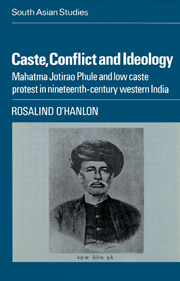 Caste, Conflict and Ideology
Caste, Conflict and Ideology from Part 4 - The creation of a lower caste identity in history and popular culture, 1869–73
Published online by Cambridge University Press: 14 October 2009
Introduction
Phule endowed his ideas about the ancient past with immediate significance by integrating into his account a wealth of practices, beliefs, and symbols from contemporary popular culture and religion. In this way, he hoped to make it possible for potential followers to ‘discover’ a common identity for all lower castes. This identity existed in the midst of familiar institutions and traditions. Its true significance had always been concealed by the mystifications of Brahmanic religion.
The figures which feature most prominently in Phule's account are the god Khandoba, and the good Daitya King Bali of Hindu mythology. In Khandoba, Phule chose one of the central figures of popular religious culture in Maharashtra, the god who was the kuladevata or guardian deity of the Maratha and kunbi group of castes. His chief shrine was (and still is) at Jejuri. He is pictured here as a linga, although as the guardian deity of the Deccan he is more often portrayed as a horseman with a sword in his right hand. He was also worshipped under different names according to his various aspects. The gods Mhasoba, Bahiroba, and Martand were all different names of Khandoba. Likewise they were central figures in the religious and agricultural year of western Maharashtra's largest group of cultivating and peasant castes. Originally, Khandoba was probably a local deity, and has been Sanskritised as an incarnation of Shiva. In a sense, Phule was trying to reverse this process of the Sanskritisation of local deities, and to detach this local religious tradition from its association with the all-India traditions of Hinduism.
To save this book to your Kindle, first ensure [email protected] is added to your Approved Personal Document E-mail List under your Personal Document Settings on the Manage Your Content and Devices page of your Amazon account. Then enter the ‘name’ part of your Kindle email address below. Find out more about saving to your Kindle.
Note you can select to save to either the @free.kindle.com or @kindle.com variations. ‘@free.kindle.com’ emails are free but can only be saved to your device when it is connected to wi-fi. ‘@kindle.com’ emails can be delivered even when you are not connected to wi-fi, but note that service fees apply.
Find out more about the Kindle Personal Document Service.
To save content items to your account, please confirm that you agree to abide by our usage policies. If this is the first time you use this feature, you will be asked to authorise Cambridge Core to connect with your account. Find out more about saving content to Dropbox.
To save content items to your account, please confirm that you agree to abide by our usage policies. If this is the first time you use this feature, you will be asked to authorise Cambridge Core to connect with your account. Find out more about saving content to Google Drive.